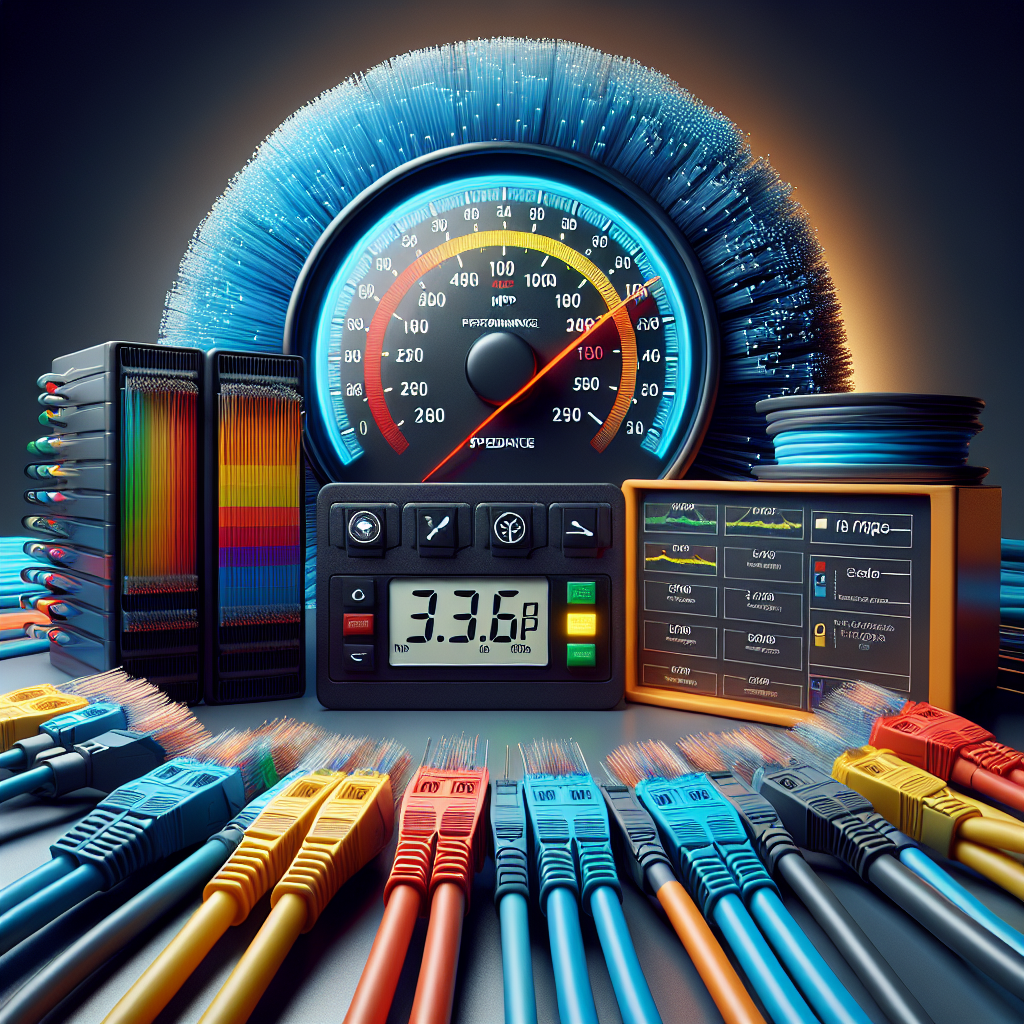Fiber optic internet has revolutionized the way we connect and surf the web. With blazing-fast speeds and unparalleled reliability, fiber optic internet is the gold standard for high-speed internet connections. However, not all fiber optic internet providers are created equal. In this article, we will compare the internet speeds of different fiber optic providers to help you determine which one offers the fastest and most reliable service. From download speeds to upload speeds, we will break down the data and give you all the information you need to make an informed decision about your internet service provider.
Understanding Fiber Optic Internet Speed

Fiber optic technology utilizes thin strands of glass or plastic to transmit data via light signals. This method allows for faster and more reliable internet connections compared to traditional copper wire systems.
How speed is measured in fiber optic connections
-
Bandwidth: Fiber optic internet speed is typically measured in terms of bandwidth, which refers to the maximum rate at which data can be transferred over a network. Bandwidth is usually expressed in megabits per second (Mbps) or gigabits per second (Gbps).
-
Upload and Download Speeds: Fiber optic internet offers symmetrical upload and download speeds, meaning that data can be sent and received at the same high rates. This is in contrast to other types of internet connections, such as DSL or cable, which often have slower upload speeds compared to download speeds.
Factors influencing fiber optic internet speed
-
Network Congestion: The speed of a fiber optic connection can be affected by network congestion, especially during peak usage times when many users are simultaneously accessing the internet. However, fiber optic technology is generally better equipped to handle high traffic volumes without experiencing significant slowdowns.
-
Distance from the Network Hub: The distance between a user’s location and the network hub can impact internet speed in fiber optic connections. Data transmission over fiber optics is most efficient over shorter distances, so users located closer to the network hub may experience faster speeds compared to those farther away.
-
Quality of Equipment: The quality of the fiber optic cables, modems, routers, and other networking equipment used can also influence internet speed. High-quality equipment that is properly maintained and regularly upgraded can help ensure optimal performance and faster speeds for users.
Advantages of Fiber Optic Internet Speed
Understanding Fiber Optic Internet Speed
-
High bandwidth capacity: Fiber optic internet offers significantly higher bandwidth capacity compared to traditional copper wire connections. This means that users can enjoy faster and more reliable internet speeds, even during peak usage times.
-
Consistent and symmetrical upload and download speeds: One of the key advantages of fiber optic internet speed is its ability to provide consistent and symmetrical upload and download speeds. Unlike other types of internet connections that may experience slowdowns or fluctuations, fiber optic internet offers stable speeds for both uploading and downloading data.
Comparing Fiber Optic Speed to DSL
When comparing fiber optic internet speed to DSL connections, it becomes evident that the former offers significantly faster speeds, revolutionizing the way we experience the internet. Here are some key points to consider:
-
Bandwidth: Fiber optic internet utilizes glass or plastic threads to transmit data using light signals, allowing for much higher bandwidth capacity compared to the traditional copper wires used in DSL connections. This results in faster upload and download speeds, making activities like streaming high-definition videos or online gaming seamless on fiber optic networks.
-
Latency: Fiber optic connections have lower latency or lag times compared to DSL, as the data travels at the speed of light through the fiber optic cables. This reduced latency is particularly beneficial for real-time applications such as video conferencing or online gaming, where delays can significantly impact user experience.
-
Reliability: Fiber optic connections are known for their reliability and consistency in delivering high-speed internet, even during peak usage times. On the other hand, DSL connections may experience fluctuations in speed and reliability due to factors like distance from the provider’s central office and network congestion.
-
Future-Proofing: As technology continues to advance, fiber optic internet is considered more future-proof compared to DSL. The scalability of fiber optic networks allows for easier upgrades and expansion of bandwidth to meet the increasing demands of modern internet users, ensuring a reliable and high-speed connection for years to come.
In conclusion, the comparison between fiber optic internet speed and DSL highlights the significant advantages of opting for fiber optic technology in terms of speed, latency, reliability, and future-proofing capabilities.
Comparing Fiber Optic Speed to Cable Internet
When it comes to internet speed, fiber optic technology has proven to outperform traditional cable internet in several key aspects. Here’s a closer look at how fiber optic speed compares to cable internet:
- Speed and Reliability Comparison with Cable Internet:
- Fiber optic internet operates at the speed of light, allowing for significantly faster data transmission compared to cable internet. This results in quicker download and upload speeds, making activities like streaming, online gaming, and video conferencing seamless and lag-free.
-
In contrast, cable internet relies on copper cables that can be affected by signal degradation over long distances, leading to slower speeds during peak usage times. Fiber optic connections are not susceptible to this issue, providing consistently high speeds regardless of network congestion.
-
Bandwidth Sharing and Its Effect on Speed:
- Fiber optic internet offers dedicated bandwidth to each user, meaning that your connection speed remains stable even when multiple devices are using the network simultaneously. This is in stark contrast to cable internet, where users in the same neighborhood share bandwidth, leading to potential slowdowns during high traffic periods.
- With fiber optic technology, you can expect symmetrical speeds for both uploads and downloads, while cable internet typically offers faster download speeds than uploads. This can be particularly advantageous for tasks that require fast data transfer in both directions, such as video conferencing or cloud computing.
In conclusion, when comparing fiber optic speed to cable internet, it becomes evident that fiber optic technology provides superior speed, reliability, and bandwidth allocation, making it the preferred choice for users seeking high-performance internet connectivity.
Fiber Optic vs. Satellite Internet Speed
When comparing fiber optic and satellite internet speeds, several key differences emerge that can significantly impact user experience:
-
Latency Differences between Fiber Optic and Satellite Internet
Fiber optic internet typically offers much lower latency compared to satellite internet. This is because fiber optic cables transmit data using light signals through glass fibers, allowing for near-instantaneous data transfer. In contrast, satellite internet relies on signals traveling to and from satellites in orbit, leading to higher latency due to the longer distance the data must travel. -
Speed Variations Based on Weather Conditions and Geographical Location
One notable disadvantage of satellite internet is its susceptibility to weather conditions. Heavy rain, snow, or storms can interfere with the satellite signal, causing disruptions in connectivity and slower speeds. On the other hand, fiber optic internet is largely immune to weather-related disruptions since the cables are buried underground or installed on utility poles. Additionally, the speed of fiber optic internet remains consistent regardless of geographical location, providing a reliable and high-speed internet connection for users across different regions.
Real-World Speed Tests and Case Studies
- Analysis of speed test results for fiber optic internet:
Fiber optic internet speed tests have consistently shown impressive results in real-world scenarios. Conducted in various locations and under different conditions, these tests demonstrate the reliability and speed of fiber optic connections. Results often indicate symmetrical upload and download speeds, with minimal latency and jitter. Speed tests comparing fiber optic internet with traditional broadband connections consistently show higher throughput and lower packet loss with fiber optic internet.
- Comparisons with other types of internet connections:
When compared to other types of internet connections such as cable and DSL, fiber optic internet consistently outperforms in terms of speed and reliability. Case studies have shown that fiber optic connections can achieve speeds of up to 1Gbps, making them ideal for bandwidth-intensive activities like streaming, gaming, and video conferencing. In contrast, cable and DSL connections often struggle to deliver consistent speeds, especially during peak usage hours. Additionally, fiber optic connections are less susceptible to interference and signal degradation over long distances, resulting in more stable and reliable internet performance.

Debunking Common Myths About Fiber Optic Internet Speed
In the realm of internet connectivity, fiber optic technology often stands out for its reputation of delivering unparalleled speed. However, there are common misconceptions that need to be addressed to provide a clearer understanding of fiber optic internet speed:
- Misconception 1: Fiber Optic Speed is Always Superior
One prevailing myth is that fiber optic internet speed is consistently faster than other types of connections. While it is true that fiber optics have the potential for incredibly high speeds, the actual performance can vary based on several factors. Infrastructure quality, distance from the provider, and the specific service plan chosen all play a significant role in determining the speed experienced by the end-user.
- Misconception 2: All Fiber Optic Providers Offer the Same Speed
Another misconception is that all fiber optic service providers deliver identical speeds. In reality, the speed of a fiber optic connection can differ significantly depending on the provider’s network infrastructure, capacity, and overall quality of service. Some providers may offer faster speeds due to better technology or more extensive network coverage, while others may lag behind in terms of performance.
- Clarifying the Impact of Infrastructure and Service Providers on Speed

It is crucial to recognize that the speed of a fiber optic internet connection is not solely determined by the technology itself. The infrastructure supporting the fiber network, including the quality of cables, routers, and switches, can influence the speed and reliability of the connection. Additionally, the service provider’s network management practices, bandwidth allocation, and overall network congestion levels can all impact the speed experienced by users. It is essential for consumers to consider these factors when evaluating the speed potential of a fiber optic internet service.
Future Prospects of Fiber Optic Internet Speed
Fiber optic technology is continuously evolving, with ongoing research and development focused on enhancing internet speeds. Advancements in fiber optic cables, such as using denser wavelengths and improving signal processing techniques, have the potential to significantly increase data transmission rates. These improvements could pave the way for even faster internet speeds, surpassing the capabilities of traditional broadband connections.
The future prospects of fiber optic internet speed are promising, as researchers are exploring innovative methods to boost bandwidth capacity and reduce latency. By harnessing cutting-edge technologies like multiplexing and advanced modulation schemes, fiber optic networks may soon achieve speeds that exceed current industry standards. This could revolutionize the way we access and utilize the internet, enabling seamless streaming, real-time collaboration, and rapid data transfer on a global scale.
In the coming years, the impact of enhanced fiber optic internet speeds is expected to be far-reaching. From enabling smoother video conferencing and online gaming experiences to supporting the Internet of Things (IoT) devices, faster internet connections can drive digital transformation across various sectors. Businesses can leverage high-speed fiber optic networks to enhance productivity, streamline operations, and deliver high-quality services to customers. Additionally, consumers stand to benefit from quicker downloads, reduced buffering times, and improved overall internet performance.
As fiber optic technology continues to advance, the future of internet connectivity appears to be increasingly reliant on high-speed, reliable fiber optic networks. By embracing these developments and investing in infrastructure upgrades, countries can position themselves at the forefront of the digital age, ensuring seamless connectivity for their citizens and businesses.
FAQs: Fiber Optic Internet Speed Comparison
How does fiber optic internet speed compare to traditional broadband speeds?
Fiber optic internet typically offers much faster speeds compared to traditional broadband technologies such as DSL or cable. With fiber optic networks, users can experience speeds of up to 1 Gbps or even higher, leading to smoother streaming, faster downloads, and quicker online gaming experiences.
Are there any factors that can affect the speed of fiber optic internet?
While fiber optic internet offers impressive speed capabilities, the actual speed experienced by users can be influenced by various factors. These factors include the quality of the fiber optic network, the distance between the user’s location and the network’s access point, and the level of internet traffic during peak hours.
How does fiber optic internet speed compare to other high-speed internet options like 5G?
When comparing fiber optic internet to other high-speed internet options such as 5G, fiber optic technology often offers more consistent and reliable speeds. While 5G can provide fast speeds, the reliability and coverage may vary depending on the user’s location and network congestion. Fiber optic internet, on the other hand, typically provides a more stable and consistent connection.
Can fiber optic internet speeds vary between different internet service providers?
Yes, the speed of fiber optic internet can vary between different internet service providers. Factors such as the quality of the provider’s network infrastructure, the level of internet traffic in the area, and the chosen internet plan can all impact the speed experienced by users. It is important for users to research and compare different providers to find the best option that meets their specific speed requirements.